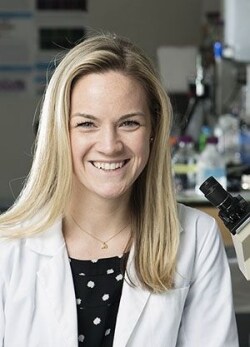Search


Life Sciences Solutions, Information and Scientainment
Greener life in the lab
For our colleagues in Bangalore, they chose to focus on closing the loop with Gibco media bottles. Watch the video to see how sustainability became a shared pursuit.
Each step, no matter how small, is testament to the continuous pursuit of sustainable science. Below are researchers who are sharing stories, tips, and tricks to going green.

Lindsey Avery Fitzsimons
Instructor of Gross Anatomy and Histology
University of New England, PhD Candidate, University of Maine
“Even though we are a small lab with modest funding sources, we are committed to minimizing our environmental impact as much as each experiment can allow. We have switched to Thermo Fisher Art Universal Barrier and Non-filtered tip reload systems, which has allowed our lab to reduce our overall consumables waste. We have recently replaced our -80°C freezer with an energy-efficient Thermo Fisher ultra low-temperature freezer. Due to the efficiency and resiliency of this freezer, we are able to store our reagents at -70°C to further conserve energy.
Along with choosing the convenient rack systems, we have been able to organize our storage in an incredibly efficient manner, further minimizing the time required to open the freezer door when looking for specific samples—even the ones that are put in the very back, hard to reach corners—you know the ones!
In general, we do our best to be cognizant of our plastic consumption and waste and to be proactive in re-using, re-purposing, and/or recycling what we can. For example, the GIBCO cell culture media bottles are always repurposed to house pipette tip waste, and they also make excellent flowerpots—so many additional uses prior to a recycling option.
I have recently acquired a sample of the new GIBCO BenchStable DMEM cell culture medium and further look forward to being able to minimize our refrigeration storage to allow for optimal temperature regulation.
Thermo Fisher has made these transitions easy, with regular promotions, sampling options, and their Aspire loyalty program* that allow us to get the most for our funding dollars while still obtaining the highest quality lab supplies an reagents we depend upon to produce good, sustainable science.


Aman Sharma
PhD Candidate, University of Massachusetts, Amherst
Our lab has become more sustainable. I mainly use public transportation, and my advisor often rides his bike to work. Now, we use Google Drive to maintain our protocols and experimental data. For lab inventory and other stuff, we use Quartzy to keep the records of our cell lines/tissues and order lab stuff.

Emily Weigel
Ecology Lab Instructor, Georgia Institute of Technology
Moving from a traditional wet lab to a building that meets the Living Building Challenge, the Georgia Tech Ecology Lab and its curriculum have been explicitly (re-)designed to generate zero water, energy, and supply waste. Hundreds of students now test the limits of ecological sustainability using the building’s biodiversity and rooftop gardens.

Steven Nguyen
Lab Manager, Janssen Pharmaceutical Companies of Johnson & Johnson
My team will use everything obtainable to create a research environment that is sustainable. We saw something deficient, so we then moved to cold storage that is more energy efficient. We prioritized reusables, shared reagents, recycling, and less waste, as the greatest needs first. We will do our best to help the earth.

Energy efficient
Did you know freezers and fridges make up for most of a lab’s energy use? Learn what we mean by “energy efficient” and things you can do now to save energy.

Less hazardous
What does “less hazardous” really mean? Find out about how we evaluate less hazardous products and learn about the ACT label, an eco-nutrition label that helps you make greener choices for the lab.

Sustainable packaging
Packaging design must consider how to protect the product and minimize impact on the environment. We’re started using 100% recyclable paper coolers for cold shipping and that’s only the beginning.

Less waste
We have criteria for what “less waste” means, and it’s more than reducing what gets sent to landfills. Find out how we evaluate minimizing waste in the lab.
Sustainability is a continuous pursuit.
Join us on our path towards sustainable science, and learn about what we’re doing as a company and in partnership with the scientific community. You can also stay in the know with our blog for more green news and perspectives from around the world.

One shared pursuit
Hear from Cristina Amorim, VP of EHS & Sustainability as she shares ways in which we're taking steps towards serving our customers in sustainable ways, including: 14 zero waste-certified facilities and a recent commitment to reduce greenhouse gas emissions by 30% by 2030.
Life in the Lab blog
The latest industry trends, innovations, educational resources and scientainment to empower your life in the lab. Read more
* Currently in North America only. Terms, conditions, and restrictions apply to all benefits. Learn more ›
仅供科研使用,不可用于诊断目的。